RBSE Solutions for Class 8 Maths Chapter 7 Cube and Cube Roots Intext Questions
Rajasthan Board RBSE Solutions for Class 8 Maths Chapter 7 Cube and Cube Roots Intext Questions Textbook Exercise Questions and Answers.
RBSE Class 8 Maths Solutions Chapter 7 Cube and Cube Roots Intext Questions
(Try These Page No: 111)
Question 1.
Find the one’s digit of the cube of each of the following numbers.
(i) 3331
(ii) 8888
(iii) 149
(iv) 1005
(v) 1024
(vi) 77
(vii) 5022
(viii) 53
Answer:
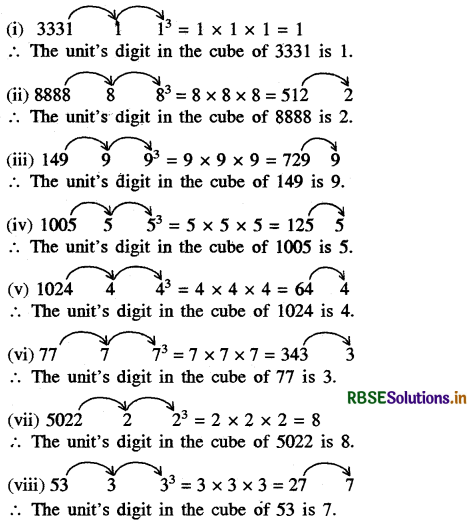

(Page No: 111)
Question 1.
Express the following numbers as the sum of odd numbers using the above pattern?
(a) 63
(b) 83
(c) 73
Answer:
Pattern 1 = 1 = 13
3 + 5 = 8 = 23
7 + 9 + 11 = 27 = 33
13 + 15 + 17 + 19 = 64 = 43
21 + 23 + 25 + 27 + 29 = 125 = 53
Using the above pattern,
(a) 63 = 31 + 33 + 35 + 37 + 39 + 41 = 216
(b) 83 = 57 + 59 + 61 + 63 + 65 + 67 + 69 + 71 = 512
(c) 73 = 43 + 45 + 47 + 49 + 51 + 53 + 55 = 343
Question 2.
Consider the following pattern.
23 - 13 = 1 + 2 × 1 × 3
33 - 23 = 1+ 3 × 2 × 3
43 - 33 = 1 + 4 × 3 × 3
Using the above pattern, And the value of the following.
(i) 73 - 63
(ii) 123 - 113
(iii) 203 - 193
(iv) 513 - 503
Answer:
Using Ihe given pattern—
(i) 73 - 63 = 1 + 7 × 6 × 3 = 1 + 126 = 127
(ii) 123 - 113 = 1 + 12 × 11 × 3 = 1 + 396 = 397
(iii) 203 - 193 = 1 + 20 × 19 × 3 = 1 + 1140 = 1141
(iv) 513 - 503 = 1 + 51 × 50 × 3 = 1 + 7650 = 7651

(Try These Page No: 112)
Question 1.
Which of the following are perfect cubes?
(i) 400
(ii) 3375
(iii) 8000
(iv) 15625
(v) 9000
(vi) 6859
(vii) 2025
(viii) 10648
Answer:
(i) Resolving 400 into prime factors, we find that
400 = 2 × 2 × 2 × 2 × 5 × 5
Now, if we try to group together triples of equal factors we an? left with three factors 2 × 5 × 5.
∴ 400 is not a perfect cube.
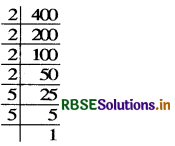
(ii) Resolving 3375 into prime factors, we
find that v -
3375 = 3 × 3 × 3 × 5 × 5 × 5
Clearly, the prime factors of 3375 can be grouped into triples of equal factors and no factor is left over.
∴ 3375 is a perfect cube.
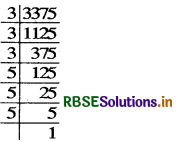
(iii) Resolving 8000 into prime factors, we find that
8000 = 2 × 2 × 2 × 2 × 2 × 2 × 5 × 5 × 5
Clearly, the prime factors of 8000 can be grouped into triples of equal factors and no factor is left over.
∴ 8000 is a perfect cube.
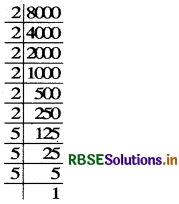
(iv) Resolving 15625 into prime factors, we get
15625 = 5 × 5 × 5 × 5 × 5 × 5
Clearly, the prime factors of 15625 can be grouped into triples of equal factors and no factor is left over.
∴ 15625 is a perfect cube.
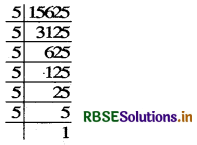

(v) Resolving 9000 into prime factors, we find that
9000 = 2 × 2 × 2 × 3 × 3 × 5 × 5 × 5
Now, if we try to group together triples of equal factors, we are left with two factors, 3 × 3.
∴ 9000 is not a perfect cube.
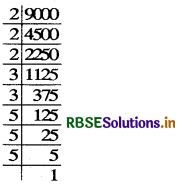
(vi) Resolving 6859 into prime factors, we get
6859 = 19 × 19 × 19
Clearly, the prime factors of 6859 can be grouped into triples of equal factors and no factor is left over.
∴ 6859 is a perfect cube.

(vii) Resolving 2025 into prime factors, we find that
2025 = 3 × 3 × 3 × 3 × 5 × 5
Now, if we try to group together triples of equal factors, we are left with three factors 3 × 5 × 5.
∴ 2025 is not a perfect cube.
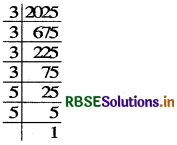
(viii) Resolving 10648 into prime factors, we find that
10648 = 2 × 2 × 2 × 11 × 11 × 11
Clearly, the prime factors of 10648 can be grouped into triples of equal factors and no factors is left over.
∴ 10648 is a perfect cube.
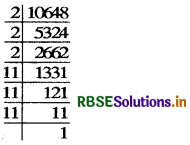

(Think, Discuss and Write Page No: 113)
Question 1.
Check which of the following are perfect cubes ?
(i) 2700
(ii) 16000
(iii) 64000
(iv) 900
(v) 125000
(vi) 36000
(vii) 21600
(viii) 10000
(ix) 27000000
(x) 1000
What pattern do you observe in these perfect cubes?
Answer:
(i) We have 2700 = 2 × 2 × 3 × 3 × 3 × 5 × 5
We do not get complete triples of prime factors, i.e. 2 × 2 and 5 × 5 are left over.
∴ 2700 is not a perfect cube.
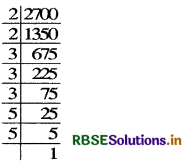
(ii) We have 16000
∴ 16000 = 2 × 2 × 2 × 2 × 2 × 2 × 2 × 5 × 5 × 5
∵ one 2 is left over.
It is not a perfect cube.
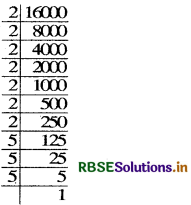

(iii) We have
64000 = 2 × 2 × 2 × 2 × 2 × 2 × 2 × 2 × 2 × 5 × 5 × 5
Since in the prime factorisation of 64000, we get groups of triples.
∴ 64000 is a perfect cube.
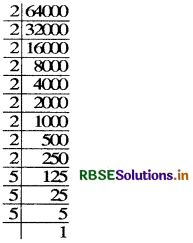
(iv) We have
900 = 2 × 2 × 3 × 3 × 5 × 5
∵ Prime factorisation of 900 is not grouped in triples.
So, it is not a perfect cube.

(v) We have
125000 = 125 × 1000
= 125 × 10 × 10 × 10
= 5 × 5 × 5 × 2 × 5 × 2 × 5 × 2 × 5
= 2 × 2 × 2 × 5 × 5 × 5 × 5 × 5 × 5
Clearly, the prime factors of 125000 can be grouped into triples of equal factors and no factor is left over.
∴ 125000 is a perfect cube.
(vi) We have
36000 = 36 × 1000 = 6 × 6 × 2 × 5 × 2 × 5 × 2 × 5
= 2 × 2 × 2 × 2 × 2 × 3 × 3 × 5 × 5 × 5
Now, if we try to group together triples of equal factors, we are left with four factors 2 × 2 × 3 × 3.
∴ 36000 is not a perfect cube.
(vii) We have
21600 = 6 × 6 × 6 × 10 × 10
= 2 × 3 × 2 × 3 × 2 × 3 × 2 × 5 × 2 × 5
= 2 × 2 × 2 × 2 × 2 × 3 × 3 × 3 × 5 × 5
∵ The prime factors of 21600 are not grouped in triples, we are left with 2 × 2 and 5 × 5.
∴ 21600 is not a perfect cube.
(viii) We have
10,000 = 10 × 10 × 10 × 10
= 2 × 5 × 2 × 5 × 2 × 5 × 2 × 5
= 2 × 2 × 2 × 2 × 5 × 5 × 5 × 5
Since the prime factors are not grouped in triples, we are left over with 2 and 5.
∴ 10,000 is not a perfect cube.
(ix) We have
27000000 = 27 × 10 × 10 × 10 × 10 × 10 × 10
= 3 × 3 × 3 × 2 × 5 × 2 × 5 × 2 × 5 × 2 × 5 × 2 × 5 × 2 × 5
= 2 × 2 × 2 × 2 × 2 × 2 × 3 × 3 × 3 × 5 × 5 × 5 × 5 × 5 × 5
Here all the prime factors of 27000000 are in group of triples.
∴ 27000000 is a perfect cube.
(x) 1000 = 2 × 2 × 2 × 5 × 5 ×5
Since, all the prime factors of 1000 are in a group of triples.
∴ 1000 is a perfect cube.

(Think, Discuss and Write Page No: 115)
Question 1.
State true or false : for any integer m, m2 < m2. Why?
Answer:
We take m = 2, 3, 4 etc.
We see that
When m = 2:
m2 = 22 = 2 × 2 = 4 and m3 = 23 = 2 × 2 × 2 = 8
Clearly, 4 < 8, i.e. m2 < m3
When m = 3:
m2 = 32 = 3 × 3 = 9 and m3 = 33 = 3 × 3 × 3 = 27
Clearly, 9 < 27, i.e. m2 < m3
When m = 4:
m2 = 42 = 4 × 4 = 16 and m3 = 43 = 4 × 4 × 4 = 64
Clearly, 16 < 64, i.e. m2 < m3
But when m = 1,
m2 = l2 = 1 × 1 = 1 and m3 = l3 = 1 × 1 × 1 = 1
Then m2 < m3
Thus we can say that for any positive integer (natural number) m > 1, m2 < m3 is true,
Now, consider m - 1, - 2, - 3 etc.
When m = - 1 :
m2 = (- 1)2 = (- 1) × (- 1) = 1
and m3 = (- 1)3 = (- 1) × (- 1) × (- 1) = - 1
Clearly, 1 > - 1, i.e. m2 > m3
When m = - 2 :
m2 = (- 2)2 = (- 2) × (- 2) = 4 and
m3 = (- 2)3 = (- 2) × (- 2) × (- 2) = - 8
Clearly, 4 > - 8, i.e. m2 > m3
Thus we can say that for any negative integer m, m2 < m3 is false.
